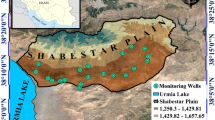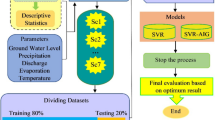Abstract
Modeling the behavior of groundwater levels is necessary to implement sustainable groundwater resource management. Groundwater is a non-linear and complex system, which can be modeled by data-driven models. This study evaluates the performances of data-driven models, support vector machine regression (SVR) and artificial neural network (ANN), for forecasting groundwater levels of confined and unconfined systems at 1-, 2-, and 3-month ahead. This is the first time that confined and unconfined aquifers have been compared using data-driven models. In addition, to identify the optimal input combination, a hybrid gamma test (GT) and genetic algorithm (GA) was used. The coefficient of correlation (R), Mean Absolute Error (MAE), root mean squared error (RMSE), Nash–Sutcliffe efficiency (NSE), and developed discrepancy ratio (DDR) were applied to evaluate the SVR and ANN models. Results showed that the SVR and ANN models were more accurate for the unconfined system than the confined system for forecasts up to 3-month ahead. In both hydrogeological systems for 1-month ahead, the models performed better than for 2- and 3-month ahead forecasts, and the accuracy of the models decreased as the months ahead increased. The SVR model performed better than the ANN model for 1-, 2-, and 3-month ahead groundwater-level forecasting. The SVR model could be successfully used in predicting monthly groundwater in confined and unconfined systems.









Similar content being viewed by others
Abbreviations
- AI:
-
Artificial intelligence
- AMSL:
-
Above mean sea level
- ANFIS:
-
Neuro-fuzzy inference system
- ANN:
-
Artificial neural network
- D:
-
River discharge
- DDR:
-
Developed discrepancy ratio
- E:
-
Evapotranspiration
- ET:
-
Entropy theory
- GA:
-
Genetic algorithm
- GEP:
-
Gene expression programming
- GP:
-
Genetic programming
- GT:
-
Gamma Test
- H:
-
Head
- LM:
-
Levenberg–Marquardt
- MAE:
-
Mean absolute error
- MLP:
-
Multi-layer perceptron
- NSE:
-
Nash–sutcliffe efficiency
- P:
-
Precipitation
- PCA:
-
Principal components analysis
- Q:
-
Water well discharge
- R:
-
Correlation coefficient
- RBF:
-
Radial basis function
- RMS:
-
Root mean squared error
- SVM:
-
Support vector machine
- SVR:
-
Support vector machine regression
- T:
-
Temperature
References
Adamowski J, Chan HF (2011) A wavelet neural network conjunction model for groundwater level forecasting. J Hydrol 407:28–40
Agalbjorn S, Koncar N, Jones AJ (1997) A note on the gamma test. Neural Comput Apply 5(3):131–133
Anderson JA (1995) An introduction to neural networks. MIT, Cambridge
Chen L, Sun C, Wang G, Xie H, Shen Z (2017) Modeling multi-event non-point source pollution in a data-scarce catchment using ANN and entropy analysis. Entropy 19:265–283
Choubin B, Malekian A (2017) Combined gamma and M-test-based ANN and ARIMA models for groundwater fluctuation forecasting in semiarid regions. Environ Earth Sci 76(15):p538
Coulibaly P, Anctil F, Bobee B (2000) Daily reservoir inflow forecasting using artificial neural networks with stopped training approach. J Hydrol 230(3):244–257
Daliakopoulos IN, Coulibaly P, Tsanis IK (2005) Groundwater level forecasting using artificial neural networks. J Hydrol 309(1–4):229–240
Durrant PJ (2001) winGamma: a non-linear data analysis and modeling tool with applications to flood prediction. PhD thesis, Department of Computer Science Cardiff University Wales, UK
Evans D, Jones AJ (2002) A proof of the Gamma test. Proc R Soc Lond 458:2759–2799
Ghorbani MA, Zadeh HA, Isazadeh M, Terzi O (2016) A comparative study of artificial neural network (MLP RBF) and support vector machine models for river flow prediction. Environ Earth Sci 75(6):p476
Guzman SM, Paz JO, Tagert MLM, Mercer A (2015) Artificial neural networks and support vector machines: contrast study for groundwater level prediction. In: ASABE annual international meeting, American Society of Agricultural and Biological Engineers
Hsu CW, Chang CC, Lin CJ (2003) A practical guide to support vector classification. Tech Reports. National Taiwan University. Taipei
Huang GB (2003) Learning capability and storage capacity of two-hidden-layer feed forward networks. IEEE Trans Neural Netw 14:274–281
Isazadeh M, Biazar SM, Ashrafzadeh A (2017) Support vector machines and feed-forward neural networks for spatial modeling of groundwater qualitative parameters. Environ Earth Sci 76(17):p610
Khaki M, Yusoff I, Islami N (2015) Simulation of groundwater level through artificial intelligence system. Environ Earth Sci 73(12):8357–8367
Khalil B, Broda S, Adamowski J, Ozga-Zielinski B, Donohoe A (2015) Short-term forecasting of groundwater levels under conditions of mine-tailings recharge using wavelet ensemble neural network models. Hydrogeol J 23:121–141
Koncar N (1997) Optimisation Methodologies for Direct Inverse Neuro-control. PhD thesis, Department of Computing Imperial College of Science Technology and Medicine University of London
Lee JM, Woo NC, Lee CJ, Yoo K (2017) Characterizing bedrock aquifer systems in Korea using paired water level monitoring data. Water 9(6):p420
Madsen KM, Perry AE (2010) Using genetic algorithms on groundwater modeling problems in a consulting setting. In: Proceedings of the Annual International Conference on Soils Sediments Water and Energy. vol. 15, pp 1–11
Maiti S, Tiwari RK (2014) A comparative study of artificial neural networks Bayesian neural networks and adaptive neuro-fuzzy inference system in groundwater level prediction. Environ Earth Sci 71(7):3147–3160
Marquez R, Coimbra CF (2011) Forecasting of global and direct solar irradiance using stochastic learning methods ground experiments and the NWS database. Sol Energy 85(5):746–756
Mohanty S, Jha MK, Kumar A, Panda DK (2013) Comparative evaluation of numerical model and artificial neural network for simulating groundwater flow in Kathajodi-Surua Inter-basin of Odisha India. J Hydrol 495:38–51
Mokhtarzad M, Eskandari F, Vanjani NJ, Arabasadi A (2017) Drought forecasting by ANN ANFIS and SVM and comparison of the models. Environ Earth Sci 76(21):p729
Mukherjee A, Ramachandran P (2018) Prediction of GWL with the help of GRACE TWS for unevenly spaced time series data in India: analysis of comparative performances of SVR ANN and LRM. J Hydrol 558:647–658
Noori R, Karbassi A, Sabahi MS (2010) Evaluation of PCA and Gamma test techniques on ANN operation for weekly solid waste prediction. J Environ Manag 91(3):767–771
Noori R, Karbassi AR, Moghaddamnia A et al (2011) Assessment of input variables determination on the SVM model performance using PCA Gamma test and forward selection techniques for monthly stream flow prediction. J Hydrol 401:177–189
Noori R, Deng Z, Kiaghadi A, Kachoosangi FT (2015) How reliable are ANN ANFIS and SVM techniques for predicting longitudinal dispersion coefficient in natural rivers? J Hydraul Eng 142(1):p4015039
Nourani V, Mogaddam AA, Nadiri AO (2008) An ANN-based model for spatiotemporal groundwater level forecasting. Hydrol Process 22(26):5054–5066
Nourani V, Alami MT, Vousoughi FD (2015) Wavelet-entropy data pre-processing approach for ANN-based groundwater level modeling. J Hydrol 524:255–269
Piri J, Amin S et al (2009) Daily pan evaporation modeling in a hot and dry climate. J Hydrol Eng 14(8):803–811
Raghavendra N, Deka PC (2015) Forecasting monthly groundwater level fluctuations in coastal aquifers using hybrid Wavelet packet–support vector regression. Cogent Eng 2(1):p999414
Remesan R, Mathew J (2015) Hydrological data-driven modeling (a case study approach). Springer International Publishing, Switzerland
Rumelhart DE, McClelland JL (1986) Parallel distribution processing: exploration in the microstructure of cognition. MIT Press, Cambridge
Safavi HR, Esmikhani M (2013) Conjunctive use of surface water and groundwater: application of support vector machines (SVMs) and genetic algorithms. Water Resour Manag 27(7):2623–2644
Sahoo S, Jha MK (2015) On the statistical forecasting of groundwater levels in unconfined aquifer systems. Environ Earth Sci 73(7):3119–3136
Shiri J, Kisi O, Yoon H, Lee KK, Nazemi AH (2013) Predicting groundwater level fluctuations with meteorological effect implications—a comparative study among soft computing techniques. Comput Geosci 56:32–44
Shirmohammadi B, Vafakhah M, Moosavi V, Moghaddamnia A (2013) Application of several data-driven techniques for predicting groundwater level. Water Resour Manage 27(2):419–432
Sreekanth PD, Sreedevi PD, Ahmed S, Geethanjali N (2011) Comparison of FFNN and ANFIS models for estimating groundwater level. Environ Earth Sci 62(6):1301–1310
Suryanarayana C, Sudheer C, Mahammood V, Panigrahi BK (2014) An integrated wavelet-support vector machine for groundwater level prediction in Visakhapatnam India. Neurocomputing 145:324–335
Thambavani DS, Mageswari TU (2015) Comparative application of ANN and PCA in modeling of groundwater. Journal of Advanced Chemical Sciences 22-26
Tian J, Li C et al (2016) Groundwater depth prediction using data-driven models with the assistance of gamma test. Sustainability 8(11):1076
Tsui APM, Jones AJ, Oliveira AG (2002) The construction of smooth models using irregular embeddings determined by a gamma test analysis. Neural Comput Appl 10:318–329
Vapnik V (1995) The nature of statistical learning theory. Springer-Verlag, New York
Vapnik V (2013) The nature of statistical learning theory. Springer, New York
Wilson ID, Jones AJ, Jenkins DH, Ware JA (2004) Predicting housing value: genetic algorithm attribute selection and dependence modeling utilizing the Gamma test. Applications of artificial intelligence in finance and economics. Emerald Publishing Limited, Bingley, pp 243–275
Yadav B, Ch S, Mathur S, Adamowski J (2017) Assessing the suitability of extreme learning machines (ELM) for groundwater level prediction. J Water Land Dev 32(1):103–112
Yan Q, Ma C (2016) Application of integrated ARIMA and RBF network for groundwater level forecasting. Environ Earth Sci 75(5):396
Zhang YX (2007) Artificial neural networks based on principal component analysis input selection for clinical pattern recognition analysis. Talanta 73:68–75
Zounemat-Kermani M, Kişi Ö, Adamowski J, Ramezani-Charmahineh A (2016) Evaluation of data driven models for river suspended sediment concentration modeling. J Hydrol 535:457–472
Author information
Authors and Affiliations
Corresponding author
Additional information
Publisher's Note
Springer Nature remains neutral with regard to jurisdictional claims in published maps and institutional affiliations.
Rights and permissions
About this article
Cite this article
Mirarabi, A., Nassery, H.R., Nakhaei, M. et al. Evaluation of data-driven models (SVR and ANN) for groundwater-level prediction in confined and unconfined systems. Environ Earth Sci 78, 489 (2019). https://doi.org/10.1007/s12665-019-8474-y
Received:
Accepted:
Published:
DOI: https://doi.org/10.1007/s12665-019-8474-y




